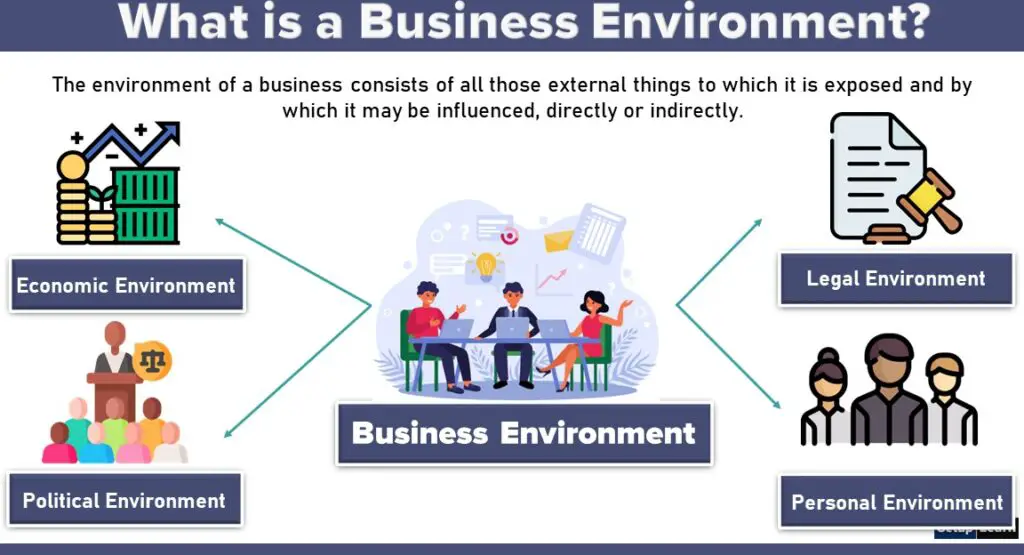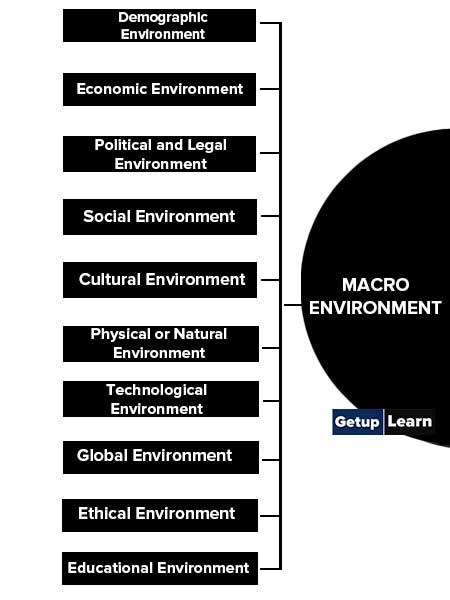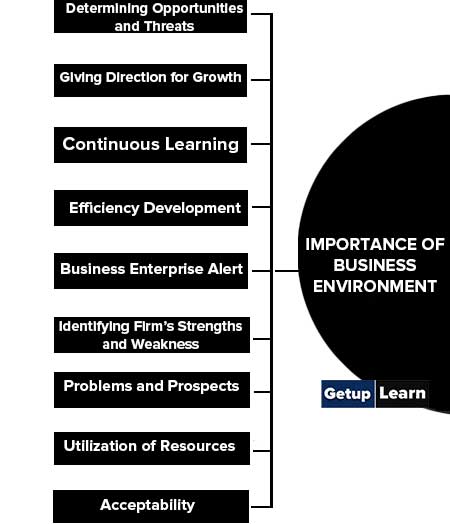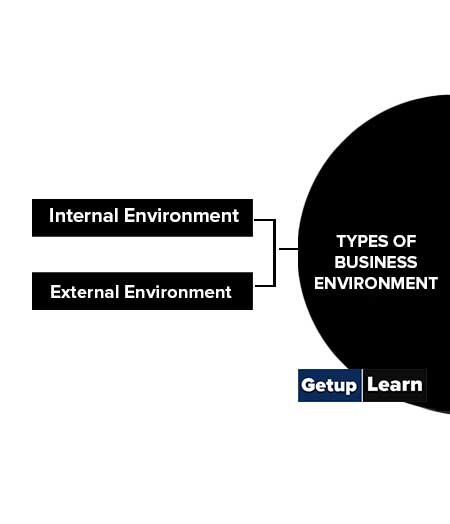Table of Contents
- 1 What do you mean by Business Environment?
- 2 Definitions of Business Environment
- 3 Types of Business Environment
- 4 Micro Environment
- 5 Macro Environment
- 6 Importance of Business Environment
- 7 Need of Environmental Studies for Business
- 8 Factors Affecting Business Environment
-
9 FAQ Related to Business Environment
- 9.1 What is a Business Environment?
- 9.2 What is the best definition of the business environment?
- 9.3 What are the 2 types of business environments?
- 9.4 What is a micro environment and examples?
- 9.5 What is Macro Environment?
- 9.6 What are the 6 macro environments?
- 9.7 What are the factors affecting business environment?
What do you mean by Business Environment?
The business Environment is the sum total of all external and internal factors that influence a business. These factors such as external factors and internal factors can influence each other and work together to affect a business.
For example, health and safety regulation is an external factor that influences the internal environment of business operations.

The business environment poses threats to a firm or offers immense opportunities for potential market exploitation. The business is determined by two factors namely:
- Microenvironment or internal factor and also known as an endogenous factor.
- Macro environment or external factor and also known as an exogenous factor.
Or you can say that the term ‘business environment’ means the sum total of all individuals, institutions, and other forces such as government policies and regulations, nature of the economy, sociocultural factors, natural factors, demographic factors, etc. that may affect the performance of the business.
Definitions of Business Environment
The following are the definitions of the business environment:
[su_quote cite=”Reinecke & Schoell”]The environment of a business consists of all those external things to which it is exposed and by which it may be influenced, directly or indirectly.[/su_quote]
[su_quote cite=”Arthur M. Weimer”]Business environment is the climate or set of conditions economic, social, political or institutional in which business operations are conducted.[/su_quote]
[su_quote cite=”Richman and Copen”]There are lots of pressures and controls which are mostly outside the control of the individual firm and its managers.[/su_quote]
[su_quote cite=”William, Glueck, and Jauch”]In the environment, there are external factors which constantly spin-out opportunities and threats to the business firm.[/su_quote]
Types of Business Environment
The business environment implies all the internal and external factors that have an impact on the business. which is why the types of business environments can be classified into two groups:
Internal Environment
The internal environment of a business consists of the factors in the company’s immediate environment that affects the performance of the company. The internal environment factors also known as endogenous factors are more directly linked with the company than the external factors. Thus it is very important to understand the internal environment because the day-to-day activities of a business are regulated by the internal environment.
External Environment
All organizations, irrespective of their goals, operate amidst changing external environment that affects and influences their managerial decisions. Management particularly at the senior and top levels must consider external factors for effective decision-making. The external environment is the actual environment of a business where the institution regulates its work.
The external environment can by the two types of environment:
Micro Environment
The microenvironment consists of the factors, which affect the company’s immediate environment. It is quite obvious that the micro environmental factors are more directly linked with the company. The micro forces need not necessarily affect all the firms in a particular industry in the same way. Some of the micro factors may be particular to a firm.
These microenvironment forces include:

Customers
The ultimate test of the success of an organization lies in winning the goodwill of existing and prospective customers. A company can not exist if it does not have adequate customers to support its infrastructure, capital, manpower, etc. Customers add value to the existence of an organization.
As it is often exhorted, the major task of a business is to create and sustain customers. A business exists only because of its customers. Monitoring customer sensitivity is, therefore, a prerequisite for business success. The choice of the customer segment should be made by considering a number of factors including the relative profitability, dependability, stability of demand, growth prospects, and the extent of competition.
Threat of Substitutes
Developments and innovations in the industry result in substitute products/ services. Companies should not only understand and analyze the threat to their business from existing substitutes but also from potential substitutes. Therefore, companies are required to continuously work out the implications to their operations arising from existing and potential substitutes and create strategies to counter their effects on their business.
Suppliers
Organizations acquire resources and add value to them by converting them into goods and services in order to achieve their objectives. An important force in the microenvironment of a company is the suppliers, i.e. those who provide various resources to organizations such as people, raw material information, finances, machines, and equipment. Suppliers, depending upon market conditions, may be in a position to dictate their terms with regard to prices and quality of resources.
Therefore, it is a vital strategic decision on the part of organizations to choose the right and dependable suppliers. Organizations in today’s environment ought to focus their efforts to develop harmonious and trustworthy relationships with their suppliers. And due to the sensitivity of the supply, many companies give high importance to vendor development. Vertical integration, where feasible, helps in solving the supply problem.
Competitors
Each organization operates in the context of its immediate competitive environment consisting of the competitors operating in the same product or service industry. This mainly consists of specific organizations with which the company directly or indirectly interacts and gets affected so far as its decisions are concerned.
Marketing Intermediaries
The immediate environment of a company may consist of a number of marketing intermediaries. According to Kotler marketing intermediaries are “firms that aid the company in promoting, selling and distributing its goods to final buyers.”
The marketing intermediaries include middlemen such as agents and merchants, physical distribution firms such as warehouses and transportations firm, marketing service agencies such as advertising agencies, marketing research firms, media firms and consulting firms, and financial intermediaries.
Marketing intermediaries are vital links between the company and the final consumers. A dislocation or disturbance of this link, or a wrong choice of the link, may cost the company very heavily. All the above factors need to be appropriately diagnosed by the managers to achieve their corporate goals and objectives by responding effectively to various environmental forces.
Macro Environment
The macro-environment forces shape opportunities and pose threats to the firm. The macro forces are, generally, more uncontrollable than the micro forces. Macro-environment that affects the working of all or most organizations includes economic systems, economic conditions, political systems, demographics, cultural background, technology, and legal framework.
The macro-environment consists of the larger societal forces which affect all the factors in the company’s microenvironment – namely, the demographic, economic, natural, technological, political and cultural forces.” The microenvironment is also known as the task environment or operating environment.
All the macro-environment factors- described below need to be continuously monitored and their implications on the operations of the organization need to be precisely identified. It is the systematic approach to environmental scanning that enables managers to identify important events and trends outside their organizations.
A detailed description of important macro environment forces is given below:
- Demographic Environment
- Economic Environment
- Political and Legal Environment
- Social Environment
- Cultural Environment
- Physical or Natural Environment
- Technological Environment
- Global Environment
- Ethical Environment
- Educational Environment

Demographic Environment
Demographic characteristics of the population reflect the details on parameters such as age profiles, gender profiles, income levels of target group, occupation pattern, size of families, growth rate, economic stratification of the population, educational levels, life expectancy, language, caste, religion etc. are all factors which are relevant to business and affect the demand for goods and services.
Economic Environment
The economic environment is the most important factor affecting business. A business firm is an economic unit; therefore, economic factors have a considerable influence on business decisions. A business policymaker or a strategic planner has to probe into the economic environment in connection with scanning the environment.
There are many economic variables and force which influences the business. The economic environment comprises the comprise the economic system, fiscal and monetary policy, level of banking institutions, industrial production, agriculture, planning, national income, per capita income, basic economic philosophy, money supply, savings, stages in the economic development, trade cycles, price mechanism, money and capital market, resource availability and resource allocation, size of the market, level of economic development, infrastructural facilities, etc.
Political and Legal Environment
The working of organizations in any society gets affected by the political and legal framework and the system within which they have to operate. The policy thrust given to different industries keeps changing with the change in political regime. Political environment refers to the influence exerted by the three political institutions, viz., legislature, executive and judiciary in shaping, directing, developing and controlling business activities.
The legislature decides on a particular course of action; the executive, also called the government, implements whatever was decided by parliament and the judiciary plays the watchdog role in order to ensure that both the legislature and the executive function are in the public interest and within the boundaries of the constitution.
Every business organization is a part of its society. It operates within society and exists primarily to satisfy its needs. Hence the business organization has an inseparable position in the very social system. While the social factors influence the policy and strategy of the business, the business organization strives to satisfy the needs and wants of society. Every business has a social responsibility.
The social environment plays a key role in determining the nature of the product, the quality of the product, the marketing strategy of the firm, etc. Businesses must be responsive to the changing needs of society. Besides maximizing profits, a firm has also to take care of the interest and welfare of society.
Cultural Environment
Cultural factors of the business environment should also be taken into consideration during the course of scanning the environment and policy formulation. Culture relates to the shared characteristics – language, religion, heritage, and values that differentiate the members of one group of people from those of another or from one nation of people from that of another, values relate to the basic beliefs of individuals and considerable importance and meaning are attached to them.
Managers need to be conscious and careful about the culture and values of their stakeholders, so as to develop and make their strategies and action compatible with them. Values of individuals greatly affect the operations of the organization, particularly to develop interpersonal relationships with the stakeholders.
The approach to identifying the problem, possible alternative solutions to the problem, clarity about ethical and non-ethical behavior, and approaches to lead and control employees largely depend upon careful analysis of cultural practices and values of people.
Physical or Natural Environment
The physical environment also influences business organizations. An organization has to take into account the influence of physical factors on the organization such as availability of land, mineral wealth, water resources, quantity and quality of existing forest wealth, the possibility of artificial rain, the exploitation of sea products like fish, the health hazards arising out of pollution, social costs of rapid urbanization and industrialization, etc.
Geographical and ecological factors, such as natural resources endowments, weather and climatic conditions, topographical factors, location aspects in the global context, port facilities, etc., are all relevant to the business.
Technological Environment
Organizations cannot grow without incorporating existing and emerging technologies in their strategic and operational plans. The technology environment exercises considerable influence on business. Technology is understood as the systematic application of scientific or other organized knowledge to practical tasks. It is through business that technology reaches people. Technology changes fast and to keep pace with it, businessmen should be ever alert to adopt changing technology to their business.
Technology has been playing a vital role in manufacturing systems and distribution networks. Thus, the operation of profit and non-profit organizations is fast changing due to changes in technology. Managers need to be alert to technological changes and their implications for their organizations, is as to effectively tackle and manage their operations.
Global Environment
Environmental factors are fast emerging as the force to reckon with in the global or international environment. Business responses and managerial practices must be fine-tuned to the global environment. Every country is influenced by international events.
Thus, the activities of every organization are affected by international factors like the rate of inflation in different nations with which it trades. In the same way, different trade barriers created by many countries affect the domestic organization and their export efforts.
Ethical Environment
Businesses have to follow the ethical values of society. Ethics refers to the code of conduct that guides an individual in dealing with others. Ethical rules differ from legal rules as much as the former is not enforced by public authority whereas the latter is enforced by the public authorities.
Legal rules become unnecessary when businessmen observe ethical rules. Society expects businessmen to act ethically. Business ethics are the key to the success of a businessman in long run. Enacting legislation and enforcing them rigidly is one way of disciplining businessmen. But legal rules are counterproductive as happened in our country. The best way is to encourage businessmen to frame their own codes of conduct and adhere to them.
Educational Environment
The business structure and environment are also affected by the prevailing education system, level of education, technological education, etc. Educational facilities and training, higher education, research and development, management courses, administrative and legal education, etc. help in the development and progress of businesses, and industries to avail the services of efficient, trained, and skilled labor.
But mere facilities of education and training are not enough for the development of the managerial class, efficient workers, and technocrats. It is also essential that people develop a positive approach and attitude toward education and training.
Importance of Business Environment
The followings are the importance of the business environment:
- Determining Opportunities and Threats
- Giving Direction for Growth
- Continuous Learning
- Efficiency Development
- Business Enterprise Alert
- Identifying Firm’s Strengths and Weakness
- Problems and Prospects
- Utilization of Resources
- Acceptability

Determining Opportunities and Threats
The interaction between the business and its environment would identify opportunities for the business and threats to the business as well. It helps the business unit for meeting the challenges successfully.
Giving Direction for Growth
The interaction with the environment leads to opening up new frontiers of growth for the firms. It enables the business to identify the areas for growth and expansion of its activities.
Continuous Learning
The environmental analysis makes the task of managers easier in dealing with business challenges. The managers are motivated to continuously update their knowledge and skills to meet the predicted changes in the realm of business.
Efficiency Development
Environmental understanding helps business organizations in improving their functioning by showing their sensitivity to the environment within which they are working. For example, in view of the shortage of power, many companies have set up Captive Power Plants (CPP) in their factories to meet their own requirements for power.
Business Enterprise Alert
The use of environment study will keep busy- the ness unit alert in vision and approach. Without change, business activities become dull and carry no life. It is found the prospects of the business are understood by way of such business study of a particular environment. It makes an establishment handle related problems with confidence and confidence.
Identifying Firm’s Strengths and Weakness
The business environment helps to identify individual strengths and weaknesses in view of technological and global developments.
Problems and Prospects
Through the studies of the business environment, the user or customer will be able to understand the type of future problems and their prospects of business well in advance. It makes the business organizations handle related problems strongly in order to handle favorable situations.
Utilization of Resources
In the study of the business environment, it is clear that the optimum use of resources can be made available by studying the economic and technological environment. With the study of such an environment helps the organization to achieve maximum benefit of policies, concessions, and developments.
Acceptability
The study of the business environment allows a businessman to expand their business and make him work on social networks. By this, the business organizations result in positive acceptance of maintaining ecological setup by learning various social business environments.
Need of Environmental Studies for Business
In general, the business will work and flourish if the environment is clean and supportive. The inputs in terms of human, physical, and financial resources are drawn from the environment. It is the working of business that will convert such types of resources with several processes in terms of outputs of products and services. There occur three basic objectives of environmental analysis in terms of business such as:
- To examine and predict current and potential changes that take place in an environment.
- Should provide inputs in order to prepare strategic decisions.
- To carry out and foster strategic thinking in an organization.
Apart from these, there are problems that make an environment to influence and analyze based on complexity, diversity, uncertainty, and limitations. There are the certain frameworks that made the environment to understand is:
- Initial view about uncertainty.
- Auditing environmental influences to find important factors that will affect the organization’s development or performance.
- To stress explicit consideration of the current environment of an organization.
Normally today, business needs to be environmentally sound and clean. There are two basic opinions that take care of the environment: Introduction to Indian Business Environment.
Keeping the environment clean is very expensive so keep the prices low as desired by the consumers.
- Protecting of environment results in expense and reduced profits.
- As there will be more prices, it means increased costs.
- Establishments should be competitive as compared to those that are not environmentally friendly.
Consumers need to have businesses with social responsibility.
- This clean and efficient machinery will benefit the business in the longer run.
- With the effect of environmental issues, social responsibility for businesses will increase.
- With the use of scarce resources, it will be nothing for future generations and raise prices.
Factors Affecting Business Environment
Factors affecting business environment are discussed below:
- Economic Factors
- Cultural Factors
- Social Factors
- Demographic Factors
- Geographical Factors
- Technological Factors
- Legal Factors
- Government Factors
- Political Factors
Economic Factors
Economic factors involve the Size Of The Economy Composition Of The Environment, Economy, Economic Health, Economic Policies – Fiscal Monetary And Entrepreneurial Foreign Capital, etc.
Cultural Factors
Cultural factors revolve around the Cultural Life Of People Rites, Rituals, Environmental Festivals, Heritage Invasion Of Alien Culture Business, Culture Roles, etc.
Social factors include Social Practices, Social Classification Environment Like Caste Religion, And Community, and Social Institutions Like Family, Marriage, etc in society.
Demographic Factors
Demographic factors such as Size Of Population Composition Of Environment, Population, Family Size, Language, literacy rate, etc can have a greater influence on business.
Geographical Factors
The Geo-Peculiarities Of A Region Like Environment, The Terrain Vegetation Cover Location Attitude, Rainfall, Climate, etc are included in geographical factors that need to study for success of business.
Technological Factors
Technological Orientations, Research Environment Development, Technology Import And Absorption, Technological Obsolescence, etc.
Legal Factors
Business Related Laws Governing Environment Competition, Consumer Protection, Contractual Obligations, Regulation Of Foreign Participation, Respect For Judiciary Efficiency Of The Same, etc are legal factors that needed to considere when operating business activities.
Government Factors
System Of Government Distribution Of Environment, Power Between National And Local Government, Culture Of Civil Servants, Government Policy On Businesses, etc are government factors.
Political Factors
Political factors involes the Political System, Political Institutions, Political Environment, Political Ideologies Of Parties, Political Stability, Political Culture, etc.
What is a Business Environment?
The environment of a business consists of all those external things to which it is exposed and by which it may be influenced, directly or indirectly.
What is the best definition of the business environment?
By Arthur M. Weimer: “Business environment is the climate or set of conditions economic, social, political or institutional in which business operations are conducted.
What are the 2 types of business environments?
The business environment can be classified into two groups:
1. Internal Environment: The internal environment of a business consists of the factors in the company’s immediate environment that affects the performance of the company.
2. External Environment: All organizations, irrespective of their goals, operate amidst changing external environment that affects and influences their managerial decisions.
What is a micro environment and examples?
Micro Environment: The company’s immediate environment where routine activities are affected by certain actors. Suppliers, marketing intermediaries, competitors, customers and the public operate within this environment. It is not necessary that the micro factors affect all the firms. Some of the factors may affect a particular firm and do not disturb the other ones. So, it depends on that on what type of industry a firm belongs to. Now let’s discuss in brief some of the microenvironmental factors.
What is Macro Environment?
Macro Environment: With the rapidly changing scenario, the firm must monitor the major forces like demographic, economic, technological, political/legal and social/cultural forces. The business must pay attention to their casual interactions since these factors set the stage for certain opportunities as well as threats. These macro factors are, generally, more uncontrollable than the micro factors.
What are the 6 macro environments?
The following are 6 macro environments: Demographic Environment, Economic Environment, Political and Legal Environment, Social Environment, Cultural Environment, Physical or Natural Environment, Technological Environment, Global Environment, Ethical Environment, Educational Environment etc.
What are the factors affecting business environment?
Factors Affecting Business Environment
1. Economic Factors
2. Cultural Factors
3. Social Factors
4. Demographic Factors
5. Geographical Factors
6. Technological Factors
7. Legal Factors
8. Government Factors
9. Political Factors


